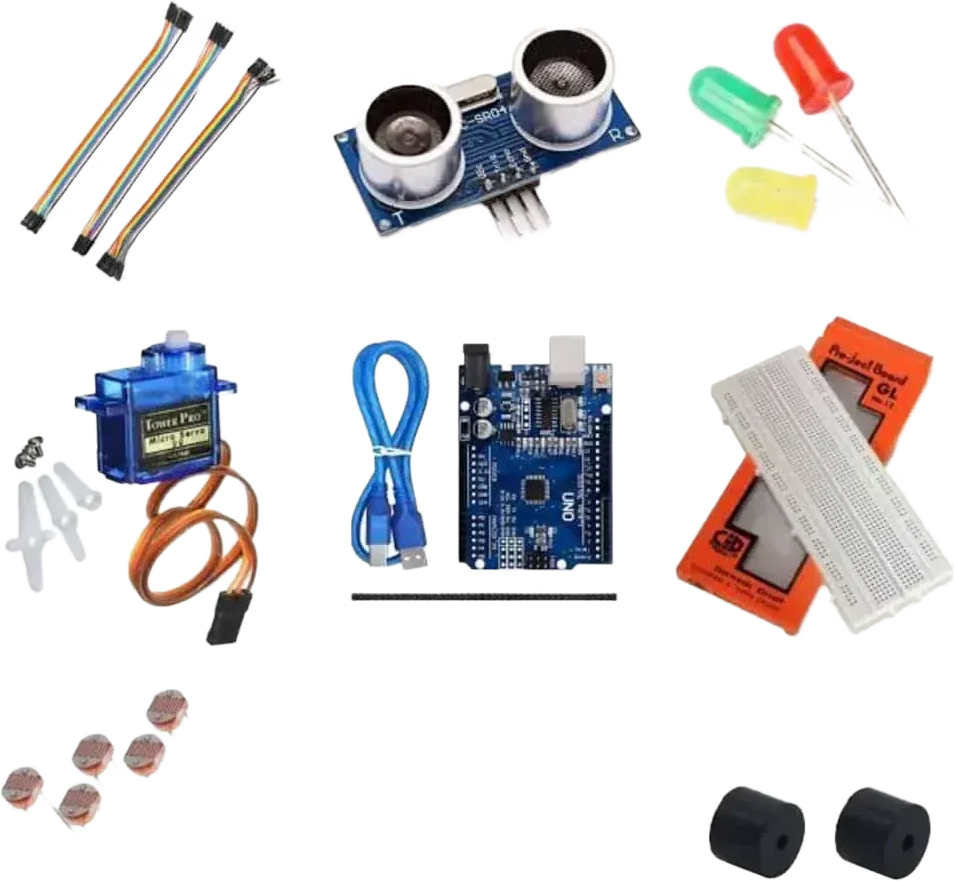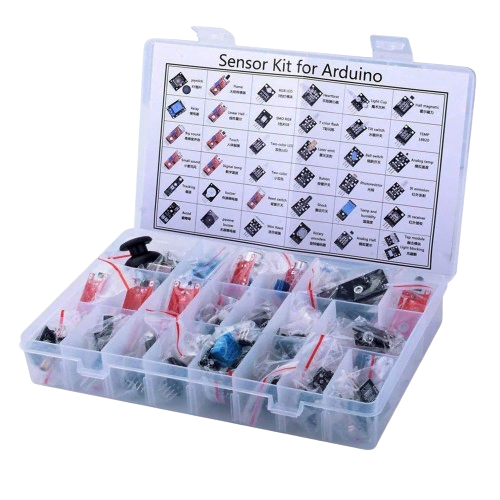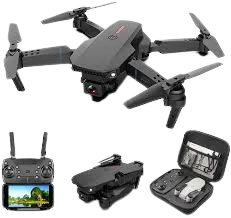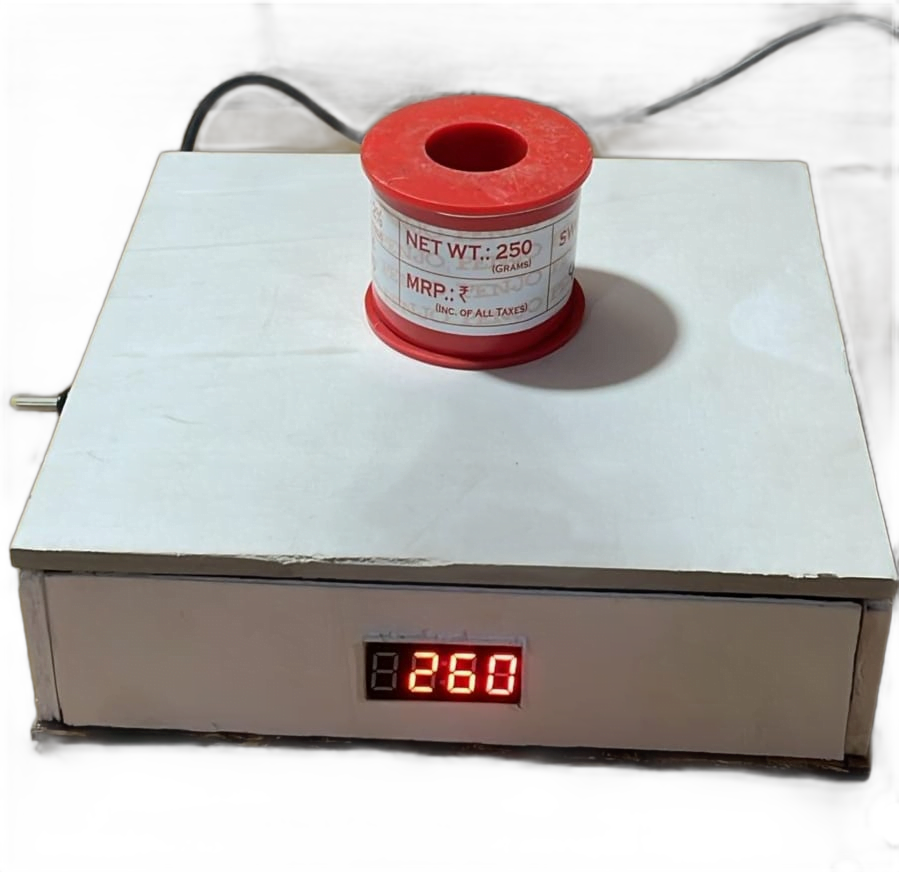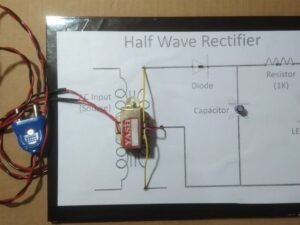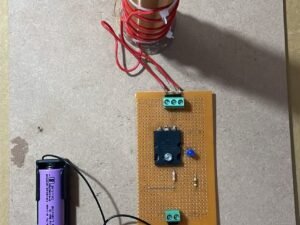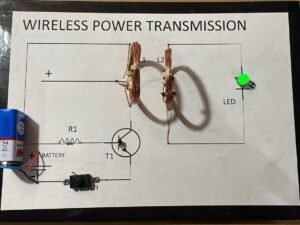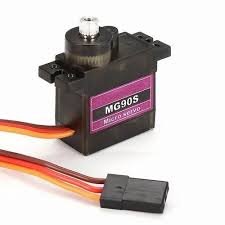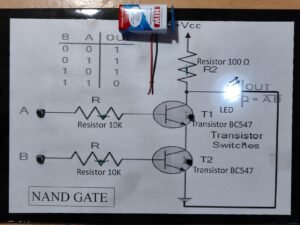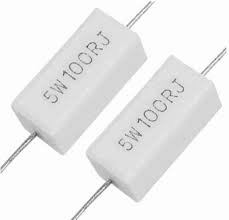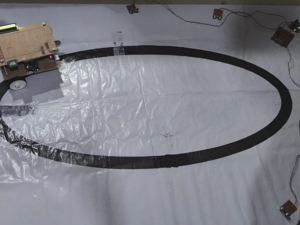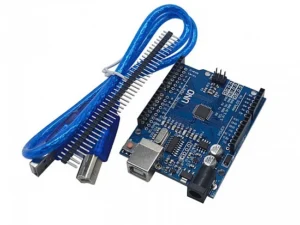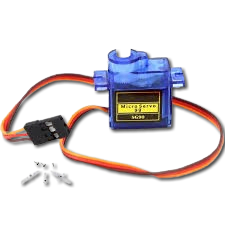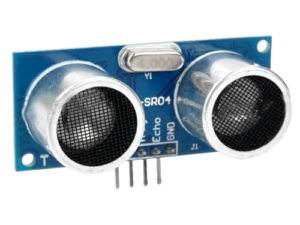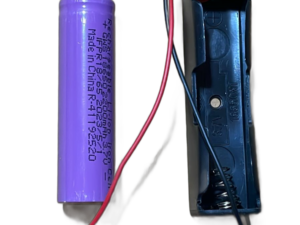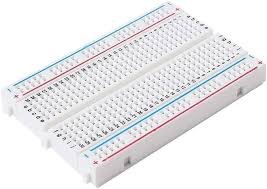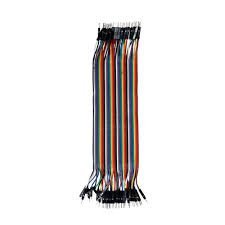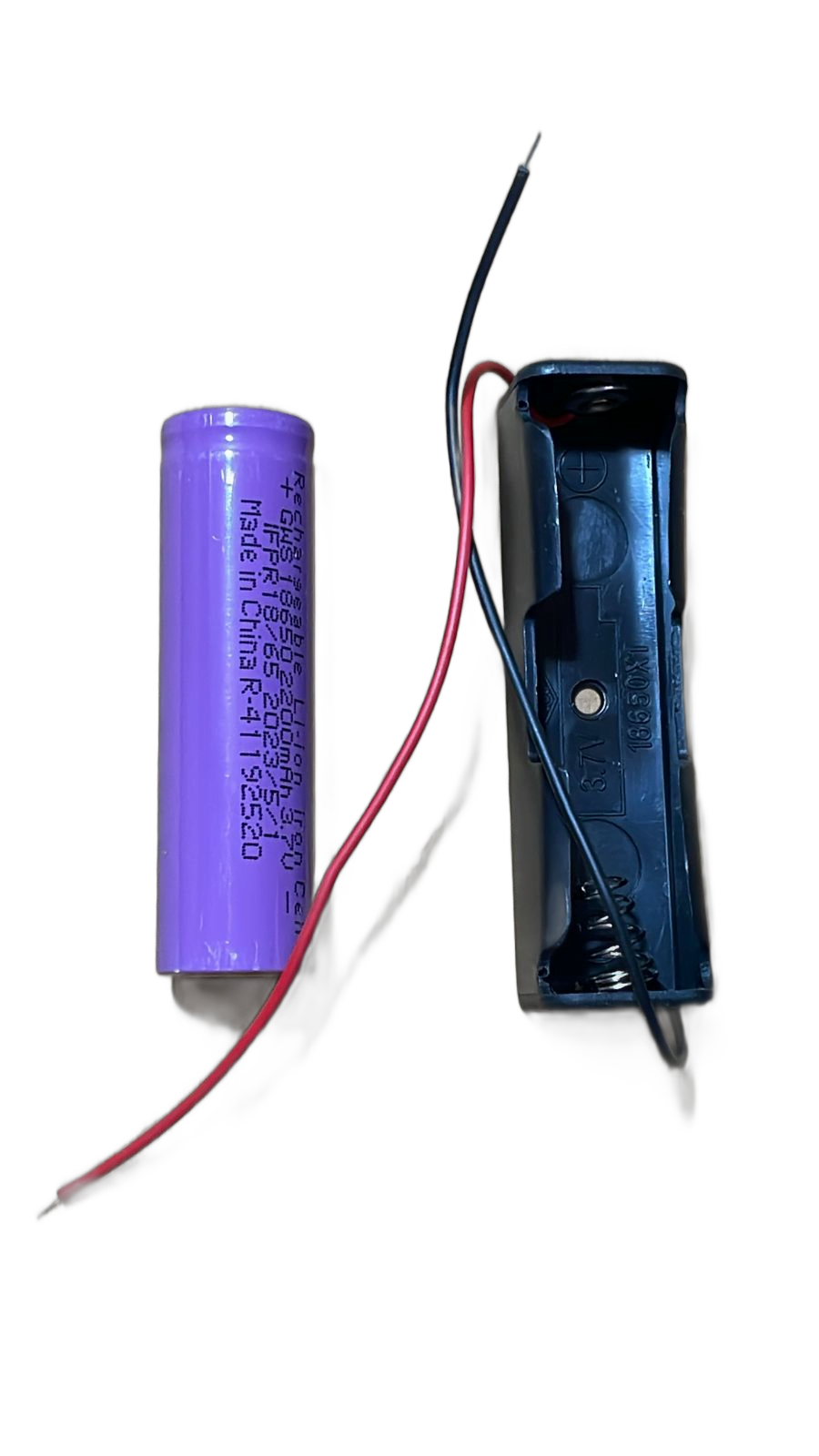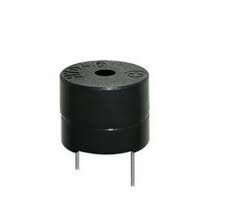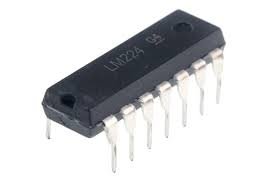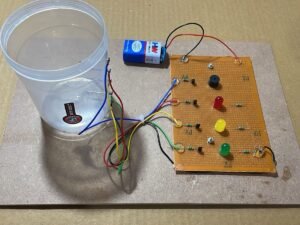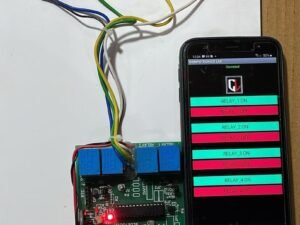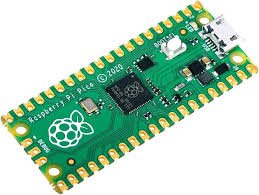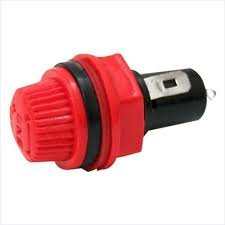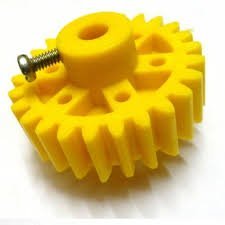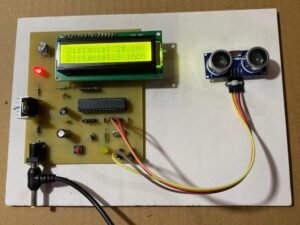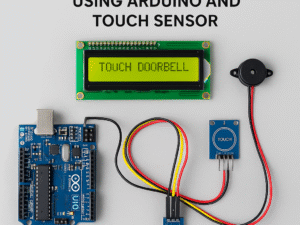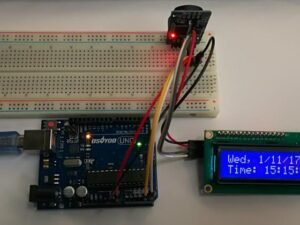The Smart Coffee/Drink Temperature Control Cup uses a Peltier module and Arduino Uno to maintain your beverage at the perfect temperature. Equipped with sensors, it continuously monitors the liquid’s heat level and adjusts accordingly using the Peltier effect. An OLED display shows the current temperature, and users can set their preferred heat via touch buttons or a mobile app using IoT (ESP8266/ESP32). Ideal for office desks or home use, it ensures your drink stays warm without overheating. Portable and USB-powered, this smart cup combines convenience and innovation for tech-savvy coffee or tea lovers.
Free Shipping Available
📦 Bulk Orders for Businesses!
💼 Get Exclusive Wholesale Prices
Call us at: +91-8506863227 , +91-7065689766
Special Offer
Save 4%
-
Android App Based Projects
Tourism Information System
The Tourism Information System Android Application is a comprehensive platform that enhances travel experiences by providing tourists with personalized and real-time information. Designed for ease of use, this app connects travelers with local attractions, accommodations, and essential services, making trip planning effortless and enjoyable.
SKU: Tourism Information System -
School Projects for Class 12th
Half Wave Rectifier
Click Here to Download the Circuit Diagram of “Half Wave Rectifier”
A half-wave rectifier converts AC voltage to DC voltage using a single diode. In this project, connect an AC voltage source to the input terminals of a diode, with the anode connected to the positive terminal of the AC source and the cathode to a load resistor. The diode allows current to pass only during the positive half of the AC cycle, blocking the negative half. The output across the load resistor will be a pulsating DC signal, representing only the positive half of the input AC waveform. This setup demonstrates the basic principle of rectification and provides insight into the function of diodes in power supplies.
SKU: half-wave-rectifier-project -
School Projects for Class 12th
Tesla Coil
The Tesla Coil project demonstrates wireless transmission of high-voltage electricity using a 2SC5200 transistor, a 3.7V battery, and copper coils. The primary coil generates a magnetic field, inducing voltage in the secondary coil. This creates a spark or lights up nearby objects wirelessly, showcasing electromagnetic induction and high-frequency resonance principles.
SKU: Tesla Coil -
Robot Projects
Bluetooth Voice Control Robot Car using Arduino
The Bluetooth Voice Control Robot Car using Arduino allows users to control a robot car via voice commands transmitted through a Bluetooth connection. The Arduino processes voice commands received from a smartphone app to maneuver the car. Ideal for remote-controlled projects and interactive robotics.SKU: bluetooth-remote-control-car-using-arduino-1 -
School Projects for Class 12th
Wireless Power Transmission
The Wireless Power Transfer Project explores the technology of transmitting electrical energy without physical connections. Utilizing principles such as electromagnetic induction or resonant inductive coupling, it demonstrates how power can be transferred between coils or circuits. This project is ideal for applications like wireless charging for devices, powering remote sensors, and advancing energy-efficient systems. It combines practical hands-on experimentation with fundamental electrical engineering concepts.
SKU: wireless-power-transfer-project-1 -
Servo Motors
Servo Motor MG90S
The MG90S is a compact, high-torque micro servo motor with metal gears for durability. It delivers up to 2.2 kg/cm torque and operates within 4.8V to 6V. Ideal for robotics and remote-controlled models, it offers precise control and reliability in a small, lightweight design.
SKU: servo-motor-mg90s -
Arduino Uno Programming Board's
Arduino Uno R3 DIP with Cable
Elevate your electronics projects with the Arduino Uno DIP, bundled with a reliable USB cable for instant connectivity. This compact yet powerful microcontroller board boasts 14 digital I/O pins, 6 analog inputs, a 16 MHz crystal oscillator, USB interface, power jack, and reset button. Perfect for beginners and seasoned enthusiasts alike, it’s the ultimate tool for prototyping everything from robotics to IoT devices. With its user-friendly design and vast community support, the Arduino Uno DIP is your gateway to endless innovation and creativity. Jumpstart your DIY journey today and unleash your imagination like never before!
SKU: arduino-uno-r3-dip -
B.Tech Diploma Mini Projects
LED Chaser
The LED Chaser project creates a visual effect where LEDs light up in a sequential pattern, resembling a moving wave or “chase.” Using a 555 timer IC or a dedicated LED chaser IC, the circuit generates a timed sequence that activates LEDs one by one. This project is popular for creating dynamic light displays and demonstrates basic sequential logic and timing in electronics.
SKU: led-chaser-project
-
School Projects for Class 12th
NAND Gate
Click Here to Download the Circuit Diagram of “NAND Gate”
Discover our NAND Gate project, a fundamental building block in digital electronics. Learn how to construct and apply this versatile logic gate in various circuits, essential for creating more complex digital systems. Perfect for students and hobbyists looking to deepen their understanding of logic gates and digital design.
SKU: nand-gate-project -
BTech Final Year Electronics Projects, Electrical Projects (BTech MTech), Electronics Projects (BTech MTech)
Air Purifier using Arduino
-10% BTech Final Year Electronics Projects, Electrical Projects (BTech MTech), Electronics Projects (BTech MTech)
BTech Final Year Electronics Projects, Electrical Projects (BTech MTech), Electronics Projects (BTech MTech)Air Purifier using Arduino
This project focuses on building a smart Air Purifier using Arduino, which monitors air quality and automatically purifies the air when pollution levels rise. The system uses a dust sensor (like GP2Y1010AU0F) to detect particulate matter (PM2.5/PM10) and a gas sensor (like MQ-135) to sense harmful gases such as CO₂, smoke, and ammonia.
The Arduino Uno reads these sensor values and compares them to a predefined safe threshold. If pollution levels are high, a DC fan is activated using a relay module. The fan draws air through a HEPA or activated carbon filter, cleaning it before releasing it back into the environment.
An LCD display shows real-time air quality data, and optional LED indicators give visual feedback (green for clean, red for polluted). This project is ideal for homes, offices, or classrooms, and is a great introduction to embedded systems, environmental monitoring, and automation using Arduino.
SKU: Air Purifier -
Resistors - 5 Watt
100 Ohms (5 Watt) Resistor (Pack of 2)
The 100 ohms (5 watt) resistor is a component with a resistance value of 100 ohms, designed to handle up to 5 watts of power. This high power rating allows it to dissipate significant amounts of heat while maintaining stable resistance. It is used in applications requiring both moderate resistance and substantial power dissipation, such as in power supplies, load balancing, and high-current circuits. Its robust construction ensures reliable performance and durability under heavy load conditions.
SKU: 100-ohms-5-watt -
Ceramic Capacitors
Ceramic Capacitor 3.9nf (392) (Pack of 10)
The Ceramic Capacitor 3.9nF (392) pack includes five capacitors ideal for electronic projects. These capacitors offer stability and precision with a capacitance of 3.9 nanofarads, suitable for high-frequency applications. They are compact, non-polarized, and reliable, making them essential for signal filtering and decoupling in circuits.
SKU: ceramic-capacitor-3.9nf-(392)-(pack-of-5) -
Electronics Projects (BTech MTech)
Line Following Smart Trolley System Using Arduino
The Line Following Smart Trolley System is an intelligent shopping assistant that automatically follows a designated path using infrared (IR) sensors and Arduino. This smart trolley enhances the shopping experience by reducing manual effort, making it convenient for customers in supermarkets, airports, and retail stores.
SKU: Line Following Smart Trolley System Using Arduino -
Variable Resistors
Preset 10K (Pack of 5)
The Preset 10K is a high-precision variable resistor perfect for adjusting and calibrating circuits. With a resistance of 10,000 ohms, it offers reliable performance for fine-tuning voltage, current, and signal levels in various electronic applications. Compact and durable, it ensures accurate adjustments and long-term reliability.SKU: preset-10k -
Diodes
BR1010 Bridge Rectifier (Pack of 2)
The BR1010 Bridge Rectifier is a high-efficiency device designed to convert AC to DC. With a maximum current rating of 10A and voltage rating of 1000V, it’s ideal for power supplies and chargers. Its compact, robust design ensures reliable performance in various electronic applications.
SKU: br1010-bridge-rectifier -
Switches
Self Locking Switch 6 Pin (Pack of 5)
A self-locking switch with 6 pins is a latching switch that stays in its on or off state after being pressed. It features six terminals for versatile connections, allowing control over multiple circuits. Commonly used in consumer electronics, industrial controls, and automotive systems, it offers reliability and ease of use.
SKU: Self Locking Switch 6 Pin (Pack of 5)
-
Batteries
Battery 9V with Clip
The Battery 9V with Clip provides convenient power for various electronic devices and DIY projects. Equipped with a snap-on connector, it ensures easy and secure attachment. Ideal for powering small electronics, prototyping circuits, and educational experiments, offering reliable performance in a compact form.
SKU: battery-9v-with-clip -
Arduino Uno Programming Board's
Arduino Uno R3 SMD with Cable
The Arduino Uno SMD is a compact, durable version of the popular Arduino Uno board. Featuring surface-mount components and the ATmega328P microcontroller, it offers 14 digital I/O pins, 6 analog inputs, and a USB interface for programming. Ideal for prototyping, education, and DIY electronics projects.
SKU: arduino-uno-r3-smd -
Servo Motors
Servo Motor SG90
The Servo Motor SG90 is a compact and lightweight servo, perfect for precise control in robotics and model projects. With a 180-degree rotation range, it’s ideal for steering, arm movements, and other motion control tasks. Its reliability and ease of use make it a popular choice for hobbyists and professionals alike.
SKU: servo-motor-sg90 -
Sensors and Modules
Ultrasonic Sensor Module
The Ultrasonic Sensor is a versatile device used for distance measurement and obstacle detection in robotics and automation. By emitting high-frequency sound waves and measuring the time it takes for them to return, it provides accurate distance readings. Ideal for applications such as collision avoidance, level sensing, and object counting, it enhances the functionality of various electronic systems.SKU: ultrasonic-sensor -
Batteries
Li-ion Battery Set (3.7V 2200mAh with Holder)
The Battery 3.7V 2200mAh Li-ion offers reliable, long-lasting power for various electronics. Ideal for projects requiring stable voltage and high energy density, it’s perfect for portable devices, DIY kits, and robotics. Its compact size and rechargeable capability make it a versatile choice for powering your innovative creations.
SKU: battery-3-7v -
Arduino Accessories
Breadboard 400 Points Medium
The Breadboard with 400 tie-points is ideal for medium-sized electronics projects. It features a balanced size, self-adhesive backing, and solderless connections, making it easy to use and perfect for designing and testing circuits. Suitable for educational and DIY projects, it is compatible with various standard components.
SKU: breadboard-400-points-medium -
Arduino Accessories
Jumper Wires Male to Male 40 Pin
High-quality 40-pin male-to-male jumper wires for Arduino, Raspberry Pi, and breadboard projects. Perfect for prototyping and circuit connections. Durable, flexible, and easy to use for all your electronics needs.
SKU: jumper-wires-male-to-male-40-pin
Products Grid
-
Batteries
Battery 9V with Clip
The Battery 9V with Clip provides convenient power for various electronic devices and DIY projects. Equipped with a snap-on connector, it ensures easy and secure attachment. Ideal for powering small electronics, prototyping circuits, and educational experiments, offering reliable performance in a compact form.
SKU: battery-9v-with-clip -
Arduino Uno Programming Board's
Arduino Uno R3 SMD with Cable
The Arduino Uno SMD is a compact, durable version of the popular Arduino Uno board. Featuring surface-mount components and the ATmega328P microcontroller, it offers 14 digital I/O pins, 6 analog inputs, and a USB interface for programming. Ideal for prototyping, education, and DIY electronics projects.
SKU: arduino-uno-r3-smd -
Servo Motors
Servo Motor SG90
The Servo Motor SG90 is a compact and lightweight servo, perfect for precise control in robotics and model projects. With a 180-degree rotation range, it’s ideal for steering, arm movements, and other motion control tasks. Its reliability and ease of use make it a popular choice for hobbyists and professionals alike.
SKU: servo-motor-sg90 -
Sensors and Modules
Ultrasonic Sensor Module
The Ultrasonic Sensor is a versatile device used for distance measurement and obstacle detection in robotics and automation. By emitting high-frequency sound waves and measuring the time it takes for them to return, it provides accurate distance readings. Ideal for applications such as collision avoidance, level sensing, and object counting, it enhances the functionality of various electronic systems.SKU: ultrasonic-sensor
-
Batteries
Li-ion Battery Set (3.7V 2200mAh with Holder)
The Battery 3.7V 2200mAh Li-ion offers reliable, long-lasting power for various electronics. Ideal for projects requiring stable voltage and high energy density, it’s perfect for portable devices, DIY kits, and robotics. Its compact size and rechargeable capability make it a versatile choice for powering your innovative creations.
SKU: battery-3-7v
-
Arduino Accessories
Breadboard 400 Points Medium
The Breadboard with 400 tie-points is ideal for medium-sized electronics projects. It features a balanced size, self-adhesive backing, and solderless connections, making it easy to use and perfect for designing and testing circuits. Suitable for educational and DIY projects, it is compatible with various standard components.
SKU: breadboard-400-points-medium -
Arduino Accessories
Jumper Wires Male to Male 40 Pin
High-quality 40-pin male-to-male jumper wires for Arduino, Raspberry Pi, and breadboard projects. Perfect for prototyping and circuit connections. Durable, flexible, and easy to use for all your electronics needs.
SKU: jumper-wires-male-to-male-40-pin
Best Sellers
Recently Added
Transistors
Voltage Regulator Combo Pack – 60 Pcs (6 Popular Types, 10 Each)
Voltage Regulator Combo Pack – 60 Pcs (6 Popular Types, 10 Each)
This Voltage Regulator Combo Pack is a must-have for electronics enthusiasts, students, and professionals working on circuit design, prototyping, and experimentation. The pack includes Six widely used Voltage Regulator, with 10 pieces of each type, totaling 60 Regulator.
SKU: n/a
Robot Parts
Pulley 22mm with Small Belt
A 22mm pulley with a small belt is a compact and reliable setup commonly used in applications like 3D printers, robotics, and small automation systems. The 22mm dimension typically refers to the pulley’s outer diameter, making it ideal for use in tight spaces where precise motion control is needed. When paired with a small timing belt—such as a GT2 or MXL belt—it ensures accurate, synchronized movement with minimal slippage.
This combination is well-suited for transferring rotary motion between shafts in systems requiring quiet, efficient, and low-maintenance operation. The small belt is often made of rubber with reinforced fibers for strength and flexibility. It wraps tightly around the pulley’s teeth, maintaining grip and accuracy even at high speeds.
Overall, a 22mm pulley with a small belt provides an excellent balance of precision, compact size, and mechanical efficiency, making it perfect for low-load, high-accuracy environments.
SKU: Pulley 22mm with Small Belt
Raspberry Pi and Accessories
Raspberry Pi Camera Module 2 NoIR
The Raspberry Pi Camera Module 2 NoIR is a high-quality 8MP camera designed for Raspberry Pi boards. “NoIR” stands for “No Infrared Filter,” allowing the camera to capture both visible and infrared light. This makes it ideal for night vision, low-light photography, plant monitoring, and scientific projects.
Equipped with the Sony IMX219 sensor, it can capture still images at high resolution and supports video recording at 1080p30, 720p60, and 640x480p90. The camera connects via the Raspberry Pi’s CSI interface for fast, high-quality data transmission directly to the processor.
Thanks to its sensitivity to infrared light, the NoIR camera is perfect for use with IR LEDs to record images in complete darkness. It’s lightweight, compact, and easily integrated into a wide range of projects including home automation, wildlife monitoring, and robotics.
SKU: Raspberry Pi Camera Module 2 NoIR
Python AI/ML Based Projects
Future House Price Prediction System
Future House Price Prediction System
The Future House Price Prediction System is a machine learning-based tool that forecasts the value of residential properties using historical data and key features such as location, size, number of rooms, and property age. It helps home buyers, sellers, and real estate professionals make data-driven decisions.
Built using Python and ML libraries like Scikit-learn and Pandas, the system uses algorithms like Linear Regression or Random Forest to predict future prices. Users can input property details, and the system outputs an estimated market value.
Advanced versions may include geolocation data, trend analysis, and visual dashboards for deeper insights. The platform can be integrated into a web application using Flask or Django, making it accessible and user-friendly.
This predictive system is valuable for understanding real estate trends, planning investments, and gaining a competitive edge in the property market.
SKU: Future House Price Prediction System
Arduino UNO & IOT Projects, BTech Final Year Electronics Projects, Electrical Projects (BTech MTech), Electronics Projects (BTech MTech)
IOT Based Alcohol Detector and Engine Lock system using Arduino
-11%


Arduino UNO & IOT Projects, BTech Final Year Electronics Projects, Electrical Projects (BTech MTech), Electronics Projects (BTech MTech)
IOT Based Alcohol Detector and Engine Lock system using Arduino
This project aims to design an IoT-based alcohol detection system integrated with an engine lock mechanism using an Arduino microcontroller. The system uses an MQ-3 gas sensor to detect alcohol presence in the driver’s breath. If alcohol is detected beyond a preset threshold, the system activates a relay to lock the engine, preventing the vehicle from starting.
An ESP8266 Wi-Fi module is used to send real-time alerts to a cloud server or mobile app, enabling remote monitoring. The solution enhances vehicle safety by ensuring that only sober individuals can operate the vehicle, helping reduce accidents due to drunk driving.
This smart system is cost-effective, easy to implement, and ideal for personal cars, commercial fleets, and public transport vehicles.
SKU: IOT Based Alcohol Detector and Engine Lock system using Arduino
Arduino UNO & IOT Projects, BTech Final Year Electronics Projects
IOT based Automatic Accident Avoiding Car using Arduino
-11%


Arduino UNO & IOT Projects, BTech Final Year Electronics Projects
IOT based Automatic Accident Avoiding Car using Arduino
This project presents an IoT-based Automatic Accident Avoiding Car using an Arduino microcontroller, designed to enhance road safety through obstacle detection and smart decision-making. The system uses ultrasonic sensors to continuously monitor the surroundings for nearby obstacles. When an object is detected within a critical range, the Arduino instantly stops or diverts the car to avoid a collision.
Additionally, the system integrates an ESP8266 Wi-Fi module to send real-time data or alerts to a cloud platform or mobile app, allowing for remote tracking and monitoring of the vehicle’s safety status.
This intelligent vehicle safety system can be implemented in autonomous cars, robotic vehicles, and smart transportation systems to reduce the risk of accidents and ensure safe navigation.
SKU: IOT based Automatic Accident Avoiding Car using Arduino
BTech Final Year Electronics Projects, Electrical Projects (BTech MTech), Electronics Projects (BTech MTech)
Air Purifier using Arduino
-10%


BTech Final Year Electronics Projects, Electrical Projects (BTech MTech), Electronics Projects (BTech MTech)
Air Purifier using Arduino
This project focuses on building a smart Air Purifier using Arduino, which monitors air quality and automatically purifies the air when pollution levels rise. The system uses a dust sensor (like GP2Y1010AU0F) to detect particulate matter (PM2.5/PM10) and a gas sensor (like MQ-135) to sense harmful gases such as CO₂, smoke, and ammonia.
The Arduino Uno reads these sensor values and compares them to a predefined safe threshold. If pollution levels are high, a DC fan is activated using a relay module. The fan draws air through a HEPA or activated carbon filter, cleaning it before releasing it back into the environment.
An LCD display shows real-time air quality data, and optional LED indicators give visual feedback (green for clean, red for polluted). This project is ideal for homes, offices, or classrooms, and is a great introduction to embedded systems, environmental monitoring, and automation using Arduino.
SKU: Air Purifier
Python AI/ML Based Projects
Signature Verification Using Python
Signature Verification Using Python
Signature Verification using Python is a smart way to authenticate handwritten signatures by comparing them digitally. The system checks whether a given signature matches a stored one, identifying it as genuine or forged.
Using libraries like OpenCV, the process begins with image preprocessing (grayscale conversion, thresholding, contour detection) to extract important signature features. These features include shape, stroke direction, and texture.
For classification, machine learning models like SVM or KNN are used, or advanced systems can employ Convolutional Neural Networks (CNNs) with libraries such as TensorFlow or PyTorch.
This technology is useful in banking, document verification, and legal sectors, where security and accuracy are critical. Signature verification systems reduce human error and allow for fast, automated processing.
Python’s flexibility and rich ecosystem make it ideal for building powerful signature verification applications, even with limited hardware and resources.
SKU: Signature Verification Using Python
Android App Based Projects
Real Time Object Detection Audio Output mobile App
Real Time Object Detection Audio Output mobile App
The Real-Time Object Detection with Audio Output Mobile App is a smart, AI-powered tool that uses a smartphone’s camera to identify objects in real time and provide audio feedback. It is especially helpful for visually impaired users, offering clear voice alerts like “Person ahead” or “Car on the left” as the camera detects objects.
Powered by lightweight machine learning models such as YOLO or MobileNet SSD, the app ensures fast and accurate detection directly on the device, without needing an internet connection. The built-in text-to-speech engine converts identified objects into spoken words instantly.
Key features include:
Real-time detection using phone camera
Offline audio feedback
Customizable voice and language settings
Simple, accessible interface
This app is ideal for assistive technology, robotics, or educational purposes, making AI practical and inclusive for everyday use.
SKU: Real Time Object Detection Audio Output mobile App
Robot Parts
Ultrasonic Sensor Mounting Bracket For HC-SR04
The Ultrasonic Sensor Mounting Bracket for HC-SR04 is a specially designed holder used to securely fix the HC-SR04 ultrasonic distance sensor in robotic and embedded systems projects. It provides a stable platform for accurate sensor positioning, ensuring better distance measurement and reducing the chance of vibration or misalignment during movement or operation.
The bracket is typically made from acrylic, plastic, or metal, and features pre-cut slots or holes that align perfectly with the sensor’s pins and body. It can easily be mounted onto robots, cars, or fixed stations using screws, glue, or bolts.
SKU: Ultrasonic Sensor Mounting Bracket For HC-SR04
Arduino UNO & IOT Projects, BTech Final Year Electronics Projects
Portable IoT-Based Smart Mini Refrigerator for Medical Use
-17%


Arduino UNO & IOT Projects, BTech Final Year Electronics Projects
Portable IoT-Based Smart Mini Refrigerator for Medical Use
This advanced portable mini refrigerator uses a Peltier module to maintain a stable temperature, ideal for storing medicines like insulin, vaccines, and lab samples. Powered by an Arduino Uno with IoT integration (ESP8266/ESP32), it monitors and controls temperature in real-time. Users can track data via a mobile app and receive alerts if the temperature crosses the safe range. Compact, lightweight, and rechargeable, it’s perfect for healthcare workers on the move. With an OLED display, precise sensors, and cloud-based logging, this smart fridge ensures medical items stay safe during transport or field operations.
SKU: Portable IoT-Based Smart Mini Refrigerator for Medical Use
Arduino UNO & IOT Projects, BTech Final Year Electronics Projects, Electrical Projects (BTech MTech)
Industrial Safety Helmet with Hazard Alerts & Location Tracking
-17%

Arduino UNO & IOT Projects, BTech Final Year Electronics Projects, Electrical Projects (BTech MTech)
Industrial Safety Helmet with Hazard Alerts & Location Tracking
The Industrial Safety Helmet with Hazard Alerts is designed to offer the highest level of protection for workers in hazardous environments. With its cutting-edge technology, this helmet ensures that safety is never compromised. Equipped with integrated hazard alert systems, you will remain aware of potential dangers, making it an essential piece of safety gear for construction sites, factories, and other industrial settings.
Helmet senses toxic gas, temperature, and fall.
Sends worker’s real-time data and GPS location to the control room.
SKU: Industrial Safety Helmet with Hazard Alerts & Location Tracking
Arduino UNO & IOT Projects, BTech Final Year Electronics Projects, Electronics Projects (BTech MTech)
Brain-Controlled Home Automation (EEG Headset Interface)
-11%
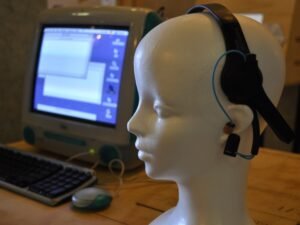

Arduino UNO & IOT Projects, BTech Final Year Electronics Projects, Electronics Projects (BTech MTech)
Brain-Controlled Home Automation (EEG Headset Interface)
Imagine controlling your home environment with just your thoughts. The Brain-Controlled Home Automation System utilizes cutting-edge EEG headset technology to offer a seamless interface between your brain and various household devices. This innovative solution empowers users to manage their smart homes without the need for physical interaction or voice commands, transforming the way you live.
SKU: Brain-Controlled Home Automation (EEG Headset Interface)
Arduino UNO & IOT Projects, Electrical Projects (BTech MTech)
Smart Energy Meter with IoT Monitoring using Arduino
-13%


Arduino UNO & IOT Projects, Electrical Projects (BTech MTech)
Smart Energy Meter with IoT Monitoring using Arduino
Introducing the Smart Energy Meter with IoT Monitoring using Arduino, a groundbreaking solution designed to bring efficiency and control to your energy consumption. This advanced meter allows you to monitor and analyze your energy usage in real-time, providing the insights necessary to optimize your electricity consumption and reduce costs.
SKU: Smart Energy Meter with IoT Monitoring using Arduino
Arduino UNO & IOT Projects
Automated Pet Feeder using Arduino with Remote Access
The Automated Pet Feeder using Arduino with Remote Access is designed for pet owners who want to simplify their feeding routines. Imagine being able to feed your pets on a fixed schedule while you’re at work or on vacation. With this innovative device, you can ensure your pets receive their meals at the right time, every time. This not only helps in maintaining their health but also gives you peace of mind.
SKU: Automated Pet Feeder using Arduino with Remote Access
Arduino Uno Mini Projects
Touch-Based Doorbell using Arduino and Touch Sensor
Touch-Based Doorbell using Arduino and Touch Sensor
The Touch-Based Doorbell is a smart and hygienic alternative to traditional mechanical doorbells. Built using an Arduino Uno and a TTP223 capacitive touch sensor, this project allows users to ring the doorbell simply by touching a sensor pad—no pressing required. It’s a great solution for smart homes and public spaces where minimizing physical contact is important.
When a user touches the sensor, it sends a signal to the Arduino, which then activates a buzzer to produce a chime sound. The system is simple, cost-effective, and easy to build. It can also be expanded by integrating features like wireless alerts or camera systems.
SKU: Touch-Based Doorbell using Arduino and Touch Sensor
Arduino Uno Mini Projects
Earthquake Detector using Arduino and Vibration Sensor
Earthquake Detector using Arduino and Vibration Sensor
The Earthquake Detector is a basic yet effective project built using an Arduino Uno and a vibration sensor (SW-420) to detect tremors or seismic activity. The sensor continuously monitors ground vibrations. When sudden or strong vibrations are detected, it sends a signal to the Arduino, which then triggers an alarm using a buzzer or LED to alert nearby individuals.
This system is simple to build and helps demonstrate how vibration sensing can be used in early warning systems. It can be further enhanced by integrating a 16×2 LCD to display real-time status or even a GSM module to send alerts remotely.
SKU: Earthquake Detector using Arduino and Vibration Sensor
Arduino Uno Mini Projects
Real-Time Clock Display using Arduino and RTC Module
Real-Time Clock Display using Arduino and RTC Module
The Real-Time Clock (RTC) Display is a practical Arduino project that shows the current time and date using an RTC module like the DS3231 or DS1307, and a 16×2 LCD with I2C interface. The RTC module keeps track of time even when the Arduino is powered off, thanks to its internal battery.
The Arduino reads the time and date from the RTC module via I2C communication and continuously updates the LCD display. It shows real-time hours, minutes, seconds, and date, making it ideal for clocks, loggers, or time-based automation projects.
SKU: Real-Time Clock Display using Arduino and RTC Module
Arduino Uno Mini Projects
Light Following Robot using Arduino and LDR Sensor
Light Following Robot using Arduino and LDR Sensor
The Light Following Robot is a fun and educational robotics project that uses Arduino Uno and LDR (Light Dependent Resistor) sensors to detect and follow a light source. It mimics the behavior of light-seeking organisms and is great for learning sensor-based automation and basic robotics.
The robot is built on a chassis with two DC motors controlled by an L298N motor driver. Two LDRs are placed at the front to sense light intensity. When one LDR detects more light than the other, the Arduino signals the motors to turn toward the brighter side. If both LDRs detect equal light, the robot moves forward.
SKU: Light Following Robot using Arduino and LDR Sensor



